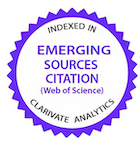Características histopatológicas do intestino delgado e quantificação de bactérias ácido-láticas de frangos de corte suplementados com plectasina
DOI:
https://doi.org/10.1590/1809-6891v25e-78210EResumo
Este estudo foi realizado para investigar as características histopatológicas do intestino delgado e quantificar a população de bactérias lácticas no ceco de frangos de corte suplementados com diferentes doses de plectasina, um peptídeo antimicrobiano com potencial para promover a saúde intestinal. O experimento incluiu dietas suplementadas com plectasina em doses de 150 ppm, 300 ppm e 450 ppm, além de um grupo controle negativo (sem antibiótico) e um controle positivo (com enramicina). A análise das lâminas de amostras do intestino delgado revelou uma diminuição na ocorrência e na gravidade das lesões histopatológicas, desde o duodeno até o íleo. Lesões no duodeno, como necrose, desepitelização das vilosidades, hemorragia e inflamação, foram reduzidas com a suplementação de plectasina, evidenciando seu potencial para promover a integridade estrutural do intestino delgado. No entanto, a avaliação da microbiota revelou uma contagem total de bactérias lácticas menor nos grupos tratados com plectasina, indicando sua incapacidade de aumentar a microbiota benéfica. Isso sugere uma melhor capacidade de absorção intestinal, com base no conceito de exclusão competitiva
Downloads
Referências
Kasimanickam V, Kasimanickam M, Kasimanickam R. Antibiotics Use in Food Animal Production: Escalation of Antimicrobial Resistance: Where Are We Now in Combating AMR? Med Sci (Basel, Switzerland). 2021;9(1).
Zhou X, Wang J, Lu C, Liao Q, Gudda FO, Ling W. Antibiotics in animal manure and manure-based fertilizers: Occurrence and ecological risk assessment. Chemosphere [Internet]. 2020;255:127006. Available from: https://doi.org/10.1016/j.chemosphere.2020.127006
Wang S, Zeng X, Yang Q, Qiao S. Antimicrobial peptides as potential alternatives to antibiotics in food animal industry. Int J Mol Sci. 2016;17(5).
Hao Y, Teng D, Mao R, Yang N, Wang J. Site Mutation Improves the Expression and Antimicrobial Properties of Fungal Defense. Antibiotics. 2023;12(8).
Oladokun S, Sharif S. Exploring the complexities of poultry respiratory microbiota: colonization, composition, and impact on health. Anim Microbiome [Internet]. 2024;6(1). Available from: https://doi.org/10.1186/s42523-024-00308-5
Gibson-Corley KN, Olivier AK, Meyerholz DK. Principles for Valid Histopathologic Scoring in Research. Vet Pathol. 2013;50(6):1007–15.
Abdul-Aziz T, Fletcher OJ, Barnes HJ, Shivaprasad HL, Swayne DE. Avian histopathology: 4th Edition [Internet]. American Association of Avian Pathologists. 2016. p. 654. Available from: https://www.aaap.info/avian-histopathology
Fathima S, Shanmugasundaram R, Adams D, Selvaraj RK. Gastrointestinal Microbiota and Their Manipulation for Improved Growth and Performance in Chickens. Foods. 2022;11(10):1–30.
Kai Y. Intestinal villus structure contributes to even shedding of epithelial cells. Biophys J [Internet]. 2021;120(4):699–710. Available from: https://doi.org/10.1016/j.bpj.2021.01.003
Wang J, Liu S, Ma J, Piao X. Changes in Growth Performance and Ileal Microbiota Composition by Xylanase Supplementation in Broilers Fed Wheat-Based Diets. Front Microbiol. 2021;12(July).
Hu F, Gao X, She R, Chen J, Mao J, Xiao P, et al. Effects of antimicrobial peptides on growth performance and small intestinal function in broilers under chronic heat stress. Poult Sci. 2017;96(4):798–806.
Quinteiro-Filho WM, Rodrigues M V., Ribeiro A, Ferraz-de-Paula V, Pinheiro ML, Sá LRM, et al. Acute heat stress impairs performance parameters and induces mild intestinal enteritis in broiler chickens: Role of acute hypothalamic-pituitary-adrenal
axis activation. J Anim Sci. 2012;90(6):1986–94.
Song J, Xiao K, Ke YL, Jiao LF, Hu CH, Diao QY, et al. Effect of a probiotic mixture on intestinal microflora, morphology, and barrier integrity of broilers subjected to heat stress. Poult Sci. 2014;93(3):581–8.
Gieryńska M, Szulc-Dąbrowska L, Struzik J, Mielcarska MB, Gregorczyk-Zboroch KP. Integrity of the Intestinal Barrier: The Involvement of Epithelial Cells and Microbiota—A Mutual Relationship. Vol. 12, Animals. 2022. 1–32 p.
Jutfelt F. Barrier Function of the Gut. Encycl Fish Physiol From Genome to Environ [Internet]. 2011;2(January 2011):1322–31. Available from: http://dx.doi.org/10.1016/B978-0-12-374553-8.00068-X
Mygind PH, Fischer RL, Schnorr KM, Hansen MT, Sönksen CP, Ludvigsen S, et al. Plectasin is a peptide antibiotic with therapeutic potential from a saprophytic fungus. Nature. 2005;437(7061):975–80.
Angelov A, Georgieva A, Petkova M, Bartkiene E, Rocha JM, Ognyanov M, et al. On the Molecular Selection of Exopolysaccharide-Producing Lactic Acid Bacteria from Indigenous Fermented Plant-Based Foods and Further Fine Chemical Characterization. Foods. 2023;12(18).
Lan PTN, Binh LT, Benno Y. Impact of two probiotic Lactobacillus strains feeding on fecal lactobacilli and weight gains in chicken. Vol. 49, Journal of General and Applied Microbiology. 2003. p. 29–36.
Nazef L, Belguesmia Y, Tani A, Prévost H, Drider D. Identification of lactic acid bacteria from poultry feces: Evidence on anti-Campylobacter and anti-Listeria activities. Poult Sci. 2008;87(2):329–34.
Apajalahti J, Vienola K. Interaction between chicken intestinal microbiota and protein digestion. Anim Feed Sci Technol [Internet]. 2016;221:323–30. Available from: http://dx.doi.org/10.1016/j.anifeedsci.2016.05.004
Ma JL, Zhao LH, Sun DD, Zhang J, Guo YP, Zhang ZQ, et al. Effects of Dietary Supplementation of Recombinant Plectasin on Growth Performance, Intestinal Health and Innate Immunity Response in Broilers. Probiotics Antimicrob Proteins. 2020;12(1):214–23.

Downloads
Publicado
Como Citar
Edição
Seção
Licença
Copyright (c) 2024 Ciência Animal Brasileira / Brazilian Animal Science

Este trabalho está licenciado sob uma licença Creative Commons Attribution 4.0 International License.
Autores que publicam nesta revista concordam com os seguintes termos:
- Autores mantém os direitos autorais e concedem à revista o direito de primeira publicação, com o trabalho simultaneamente licenciado sob a Licença Creative Commons Attribution que permite o compartilhamento do trabalho com reconhecimento da autoria e publicação inicial nesta revista.
- Autores têm autorização para assumir contratos adicionais separadamente, para distribuição não-exclusiva da versão do trabalho publicada nesta revista (ex.: publicar em repositório institucional ou como capítulo de livro), com reconhecimento de autoria e publicação inicial nesta revista.
- Autores têm permissão e são estimulados a publicar e distribuir seu trabalho online (ex.: em repositórios institucionais ou na sua página pessoal) a qualquer ponto antes ou durante o processo editorial, já que isso pode gerar alterações produtivas, bem como aumentar o impacto e a citação do trabalho publicado (Veja O Efeito do Acesso Livre).






























